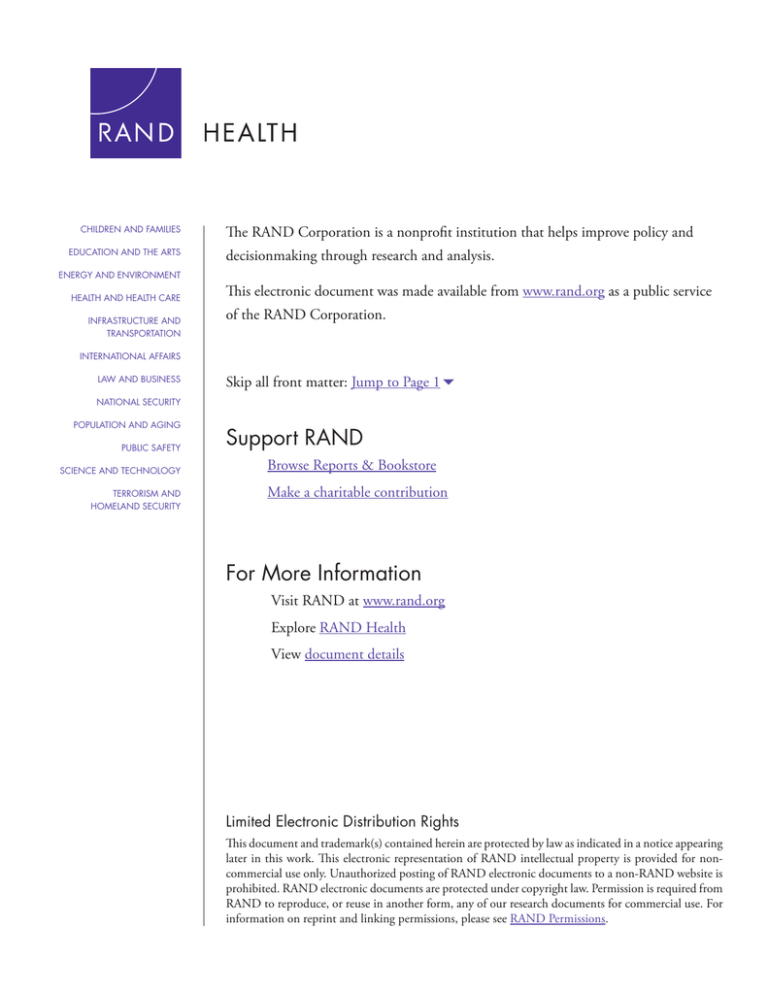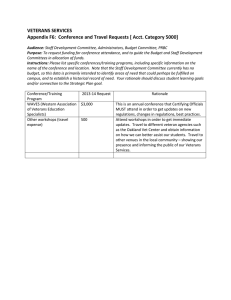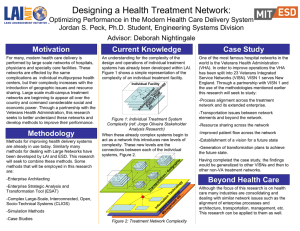The RAND Corporation is a nonprofit institution that helps improve... decisionmaking through research and analysis.
advertisement

CHILDREN AND FAMILIES EDUCATION AND THE ARTS The RAND Corporation is a nonprofit institution that helps improve policy and decisionmaking through research and analysis. ENERGY AND ENVIRONMENT HEALTH AND HEALTH CARE INFRASTRUCTURE AND TRANSPORTATION This electronic document was made available from www.rand.org as a public service of the RAND Corporation. INTERNATIONAL AFFAIRS LAW AND BUSINESS Skip all front matter: Jump to Page 16 NATIONAL SECURITY POPULATION AND AGING PUBLIC SAFETY SCIENCE AND TECHNOLOGY TERRORISM AND HOMELAND SECURITY Support RAND Browse Reports & Bookstore Make a charitable contribution For More Information Visit RAND at www.rand.org Explore RAND Health View document details Limited Electronic Distribution Rights This document and trademark(s) contained herein are protected by law as indicated in a notice appearing later in this work. This electronic representation of RAND intellectual property is provided for noncommercial use only. Unauthorized posting of RAND electronic documents to a non-RAND website is prohibited. RAND electronic documents are protected under copyright law. Permission is required from RAND to reproduce, or reuse in another form, any of our research documents for commercial use. For information on reprint and linking permissions, please see RAND Permissions. This product is part of the RAND Corporation technical report series. Reports may include research findings on a specific topic that is limited in scope; present discussions of the methodology employed in research; provide literature reviews, survey instruments, modeling exercises, guidelines for practitioners and research professionals, and supporting documentation; or deliver preliminary findings. All RAND reports undergo rigorous peer review to ensure that they meet high standards for research quality and objectivity. Veterans Health Administration Mental Health Program Evaluation Capstone Report Katherine E. Watkins, Harold Alan Pincus, Brad Smith, Susan M. Paddock, Thomas E. Mannle, Jr., Abigail Woodroffe, Jake Solomon, Melony E. Sorbero, Carrie M. Farmer, Kimberly A. Hepner, David M. Adamson, Lanna Forrest, Catherine Call Sponsored by the U.S. Department of Veterans Affairs HEALTH The research described in this report was sponsored by the U.S. Department of Veterans Affairs and was conducted by Altarum Institute and RAND Health, a division of the RAND Corporation. Altarum Institute integrates independent research and client-centered consulting to deliver comprehensive, systems-based solutions that improve health and health care. A nonprofit, Altarum serves clients in the public and private sector. The R AND Corporation is a nonprofit institution that helps improve policy and decisionmaking through research and analysis. RAND’s publications do not necessarily reflect the opinions of its research clients and sponsors. R® is a registered trademark. © Copyright 2011 RAND Corporation Permission is given to duplicate this document for personal use only, as long as it is unaltered and complete. Copies may not be duplicated for commercial purposes. Unauthorized posting of RAND documents to a non-RAND website is prohibited. RAND documents are protected under copyright law. For information on reprint and linking permissions, please visit the RAND permissions page (http://www.rand.org/publications/ permissions.html). Published 2011 by the RAND Corporation 1776 Main Street, P.O. Box 2138, Santa Monica, CA 90407-2138 1200 South Hayes Street, Arlington, VA 22202-5050 4570 Fifth Avenue, Suite 600, Pittsburgh, PA 15213-2665 RAND URL: http://www.rand.org To order RAND documents or to obtain additional information, contact Distribution Services: Telephone: (310) 451-7002; Fax: (310) 451-6915; Email: order@rand.org SUMMARY U.S. veterans have elevated rates of serious mental health and substance use disorders. Among veterans of the Afghanistan and Iraq conflicts, prolonged, repeated deployments have magnified these problems and contributed to rising rates of suicide, occupational problems, and family difficulties. Among veterans of earlier conflicts, the prevalence of mental health problems, especially post-traumatic stress disorder (PTSD), is also high. Ensuring that these veterans receive the best possible care for mental health conditions has become a national priority. Meeting the health care needs of this clinically complex and vulnerable population is the responsibility of the Veterans Health Administration (VHA), a unit within the U.S. Department of Veterans Affairs. In recent years, the VHA has made improving mental health care for veterans an institutional priority. In 2006, the VHA commissioned a comprehensive evaluation of its mental and substance use treatment system. The evaluation took place during implementation of the VHA’s five-year Mental Health Strategic Plan, a large initiative to expand and improve mental health care. To support the initiative, the VHA increased funding for mental health by $1.4 billion annually between FY 2005 and FY 2008. The goal of the evaluation was to assess whether, for the population of veterans with mental health and substance use disorders, the VHA was meeting the goal of maximizing these veterans’ physical, mental, and social functioning. The study addressed the following questions: x How much health care is used by veterans with mental health and substance use disorders, and how much does it cost? x What is the VA’s capacity to deliver mental health and substance use care to veterans? x What is the quality of mental health care received by veterans, and how does the quality compare with that delivered in the private sector? x How does quality vary across geographic regions of the United States and for different groups of veterans? x Are veterans satisfied with the care they receive? To address these questions, the research team used administrative and facilities data from the VA, as well as medical records and survey data. The team focused the analysis on veterans with one or more of five diagnoses (schizophrenia, bipolar 1 disorder, PTSD, major depression, and substance use disorders). Veterans in the Study Population Account for a Disproportionately Large and Growing Share of VHA Service Use and Costs To examine VA mental health service use and costs, the research team examined administrative data for over 3 million veterans. The team identified 836,699 veterans in 2007 with at least one of the five diagnoses noted above. Despite representing only 15 percent of the VHA patient population in 2007, these veterans accounted for one-third of all VHA medical costs (Figure S.1) because of their high levels of service use. Interestingly, most of the health care received by these veterans was for non–mental health conditions (Figure S.2). This reflects the high degree to which veterans with mental health and substance use conditions also face difficulties with physical functioning and health. Between 2004 and 2008, the number of veterans with these mental health and substance use conditions increased by 38.5 percent. Program Evaluation of VHA Mental Health Services: Capstone Report xvi Figure S.1. Veterans with Mental Health and Substance Use Disorders Account for a High Share of VA Health Care Costs NOTE: These numbers represent utilization and costs by veterans in the United States with diagnoses of schizophrenia, bipolar disorder, PTSD, major depression, and substance use disorders who received treatment from the VHA in FY 2007, presented as a proportion of total VA utilization and costs. Figure S.2. Most Service Use by Veterans with Mental Health and Substance Use Disorders is for Non–Mental Health Conditions Non-Mental Health Acute Inpatient Discharges All Inpatient Costs Outpatient Visits Outpatient Costs Total Costs 62.3% Mental Health 37.7% 42.5% 57.5% 65.2% 34.8% 78.0% 69.6% 22.0% 30.3% Proportion of FY2007 Study Veteran Total NOTE: These numbers represent mental health and non–mental health utilization and costs by veterans in the United States with diagnoses of schizophrenia, bipolar disorder, PTSD, major depression, and substance use disorders who received treatment from the VHA in FY 2007. VA Facilities Report Substantial and Growing Capacity for Treating Veterans with Mental Health and Substance Use Disorders To assess the VA’s capacity to deliver mental health and substance use care, the research team surveyed all VA facilities nationwide about the availability of basic and specialized services. Surveys were conducted in 2007 and again in 2009. In 2009, basic and specialized mental health services were reported to be Program Evaluation of VHA Mental Health Services: Capstone Report xvii widely available. The team also asked facilities about the availability of evidence-based practices (EBPs). These are therapies or other services that have been empirically linked to improved mental health outcomes. Between 2007 and 2009, the reported availability of EBPs increased substantially. For example, intensive case management, an EBP for helping patients with severe schizophrenia and bipolar disorder, was available in 68 percent of VA facilities in 2007, increasing to 82 percent in 2009. Availability of suicide prevention coordinators grew even more dramatically: In 2007, only 5 percent of VA facilities reported that a suicide prevention coordinator was available; by 2009, 99 percent of VA facilities reported offering one. The Quality of VA Mental Health Care is Generally as Good as or Better Than Care Delivered by Private Plans To assess the quality of VA mental health care, the research team compared VA performance with that of private providers serving a comparable civilian population. The team used indicators for which comparable data were available. The team found that the VA had higher levels of performance than private providers for seven out of nine indicators (Figure S.3). VA performance exceeded private-plan performance by large margins in many cases, particularly in treatment with medications and laboratory testing. The only areas in which the VA trailed private plans involved substance use disorder treatment initiation and treatment engagement. Figure S.3. The VHA Outperformed Private Plans on Seven of Nine Quality Measures NOTE: SCHIZ = schizophrenia, BP = bipolar 1 disorder, MDD = major depressive disorder. Program Evaluation of VHA Mental Health Services: Capstone Report xviii Yet the VA Does Not Always Meet Implicit Expectations Specified in Its Own Performance Guidelines Despite the VA’s strong performance compared with private providers, it does not yet meet its implicit guidelines for performance. In particular, the documented receipt of EBPs among targeted veterans was well below the reported capacity of VA facilities to deliver such care. No EBP was received by more than one-third of veterans who were targeted for that EBP. For example, among veterans receiving psychotherapy, there was low receipt of cognitive-behavioral therapy, the relevant EBP for this target population: Only 20 percent of those with PTSD and 31 percent of those with major depression received it. The team also observed low rates of relapse-prevention therapy (22 percent), an EBP for treating substance use disorders, and low rates of social-skills training (16 percent), an EBP for treating severe schizophrenia and bipolar disorder. Only about one-third of veterans with depression, schizophrenia, or bipolar disorder were in continuous treatment with medication. Quality of Care Varies Across Regions and Populations In addition to evaluating VA performance systemwide in serving the study population, the research team assessed performance at the regional level. The team defined regional as referring to each of 21 Veterans Integrated Service Networks (VISNs), which are non-overlapping, regionally oriented networks designed to pool and align resources to meet local health care needs. Variations in care across VISNs are warning flags because they may indicate that veterans in some areas of the country have less access or receive lower quality care for mental health disorders and SUDs than those in other areas. Overall, no single VISN stood out as consistently performing above or below the VISN average. However, the research team found variations across all the performance measures that were examined. For example, one of the largest variations appeared in intensive case management, an EBP for treating severe schizophrenia or bipolar disorder, which varied by more than 20 percentage points across VISNs, from 35 percent to 14 percent. There was also a 20-percentage-point difference between the highest and lowest VISN for the filling of an antidepressant medication. The team also examined variations in care for different subpopulations. The team observed lower use of appropriate services by veterans over age 65, veterans under age 35, and veterans who resided in rural areas. While these variations in care do not necessarily represent disparities, further work is needed to understand the extent to which these variations reflect differences in documentation or in actual care and why they exist. Most Veterans Expressed Satisfaction with VA Care The research team examined veterans’ perceptions of the helpfulness of VA care and the extent of their own improvement. Most veterans expressed satisfaction with VA services. Using a 10-point scale on which zero represented the least satisfaction and 10 represented the greatest, 42 percent of veterans rated VA mental health care at 9 or 10. Approximately three-quarters (74 percent) of veterans reported being helped by counseling or treatment received in the prior 12 months. Despite this favorable impression of care, however, only 32 percent of veterans perceived improvement in their problems or symptoms. Implications These findings have several implications. The size of the veteran population with mental health and substance use disorders is likely to increase as military operations in Iraq and Afghanistan decrease in size and service members leave the armed forces. Given the clinical complexity and high costs associated with these disorders, identifying ways to increase efficiency while improving quality is paramount. Moreover, even though the VA performed as well as or better than the private sector on quality measures where comparable data were available, there is room for improvement. The discrepancies between the high reported availability of EBPs and low rates of documented EBP delivery suggests that the VA can do more to increase access to these treatments. The VA represents a promising setting for quality improvement. It has a highly developed infrastructure to support quality measurement, including integration of care, electronic medical records, and more Program Evaluation of VHA Mental Health Services: Capstone Report xix complete data about treatment. Furthermore, as a self-contained care integrated delivery system, the VA can support greater standardization of clinical assessment and treatment to inform practice and promote the use of recommended care in clinical practice. In its continuing quality improvement efforts, the VA can draw on these strengths in addressing the mental health care needs of U.S. veterans and, in doing so, serve as a model for improving mental health care in the private sector as well. Program Evaluation of VHA Mental Health Services: Capstone Report xx


